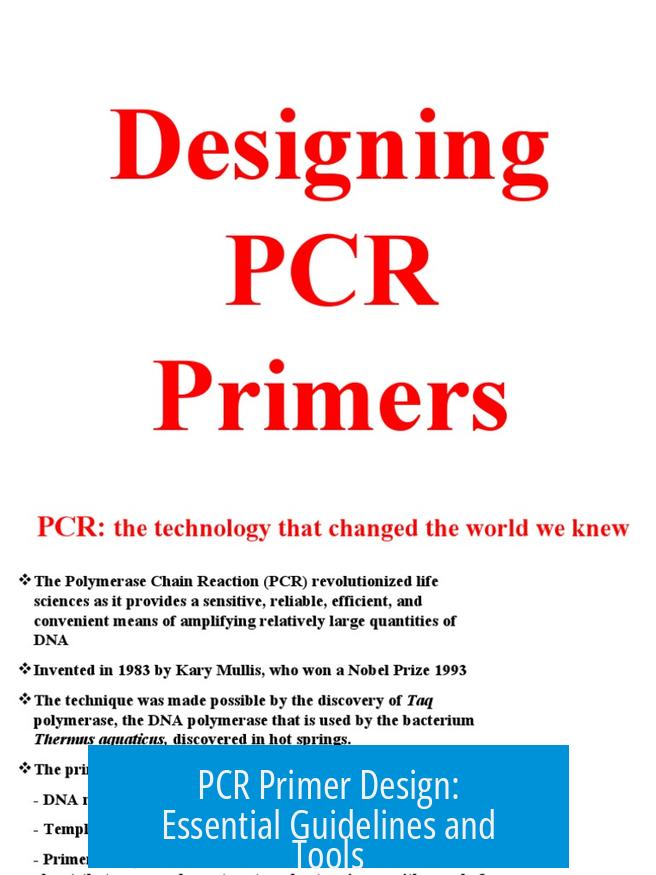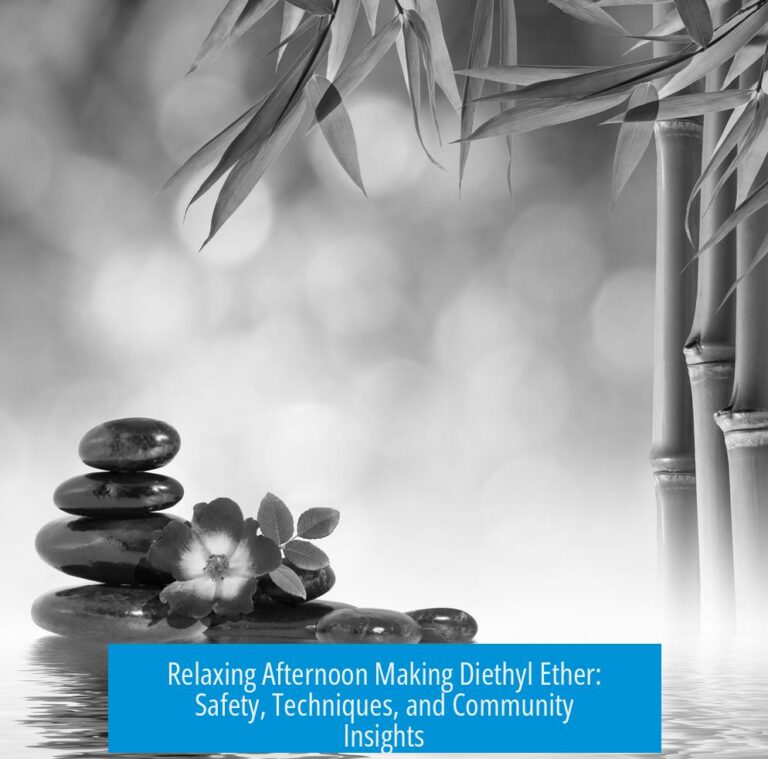PCR Primer Design: Essential Guidelines and Tools

PCR primer design requires selecting oligonucleotides typically 18-30 base pairs long with a melting temperature (Tm) near 55°C. This range balances GC content and ensures adequate binding specificity. Primers are short DNA sequences that initiate DNA synthesis in PCR, targeting specific genomic regions. The design process influences specificity, efficiency, and product yield.
Primer Length and Melting Temperature
- Optimal primer length ranges from 18 to 30 base pairs.
- A melting temperature around 55°C is preferred to maintain binding stability.
- GC content influences Tm; a balance is essential to avoid overly strong or weak binding.
A suitable primer length and Tm ensure primers bind specifically to the target DNA sequence without excessive nonspecific interactions. Overly short primers reduce specificity, while overly long primers raise Tm and may increase secondary structure formation.
Orientation and Sequence Direction
- Primers are always written from 5’ to 3’.
- The forward primer matches the top strand sequence in the 5’ to 3’ direction.
- The reverse primer is the reverse complement of the bottom strand, also in 5’ to 3’ orientation.
Understanding directionality is crucial. The forward primer binds one DNA strand and the reverse primer binds the complementary strand, allowing amplification of the intervening DNA segment.
Improving Primer Performance
- Including a 3’ GC clamp (G or C bases at the primer’s 3’ end) improves binding stability and polymerase extension.
- Forward and reverse primers should have closely matched Tm values.
- Adjust primer length when the target region is AT-rich to balance melting temperatures.
- Salt concentrations in PCR buffer impact Tm; calculators should adjust for actual reaction conditions.
Such adjustments can enhance primer annealing and reduce nonspecific amplification or primer-dimer formation.
Primer Checking Tools
Various software tools assist primer design. They calculate Tm, predict secondary structures, and ensure specificity by searching genome databases.
| Tool | Function | Remarks |
|---|---|---|
| SnapGene Viewer, Benchling | Sequence visualization and Tm calculation | Allows cursor drag to check Tm across sequences |
| Primer3 | Fundamental primer design tool | Often integrated into other software platforms |
| NCBI Primer-BLAST | Primer design with specificity checking against genome databases | Widely used for checking potential off-target binding |
| IDT PrimerQuest & OligoAnalyzer | Primer design and secondary structure analysis (hairpins, dimers) | User-friendly and thorough |
| BLAT Genome Browser | Additional primer specificity check | Visual confirmation of genome binding sites |
| NEB Tm Calculator | Calculates melting and annealing temperatures considering polymerase and salt conditions | Valuable for optimizing PCR conditions |
Practical Tips and Troubleshooting
- Check primer-dimer and hairpin formation, especially if PCR fails.
- Adjust PCR conditions to rescue difficult primers: additives like 1.2M Betaine, Hotstart enzymes, and gradient PCR programs often work.
- Ordering new primers is cost-efficient compared to extensive troubleshooting.
- Using polymerases with universal annealing temperatures (e.g., Platinum Superfi II at 60°C) simplifies protocol design.
Troubleshooting usually begins after initial failures rather than preemptive deep checks on primer secondary structures.
Gibson Assembly Primer Design Considerations
Primers for Gibson assembly contain additional overlap sequences for plasmid insertion. Design typically includes:
- Forward primer: [Overlap homology to upstream plasmid element] + [Sequence homologous to sense strand starting at start codon extending into gene]
- Reverse primer: [Sequence homologous to antisense strand starting a few bases upstream of stop codon] + [Overlap homology to downstream plasmid element]
The exact number of base pairs to include upstream or downstream (denoted as X and Y) and the length of plasmid homology depends on assembly efficiency but generally ranges from 15 to 40 bp for overlaps. Precise values depend on experimental optimization.
Conceptual Framework of Primer Design
Primer design is pragmatic and empirical. It relies on general principles rather than stringent biological rules. Strategies vary widely among researchers and sources, emphasizing practical experience. No single protocol guarantees success, necessitating iteration based on experimental feedback.
Key Takeaways
- Design primers 18-30 bp long with melting temps near 55°C for balance and specificity.
- Match Tm between forward and reverse primers; add a 3’ GC clamp for improved binding.
- Write primers 5’ to 3’, forward on the sense strand, reverse complement for reverse primer.
- Use software tools like Primer3, Primer-BLAST, and IDT OligoAnalyzer to design and validate primers.
- Troubleshoot PCR by adjusting conditions or reordering primers if necessary.
- For Gibson assembly, append homologous overlap sequences to primers for plasmid integration.
- Primer design is guided by rules of thumb and practical experience rather than fixed biological laws.
What is the optimal length and melting temperature for PCR primers?
Primers should be between 18 and 30 base pairs long. Aim for a melting temperature (Tm) around 55°C to balance GC content and ensure proper binding during PCR.
Which tools can help design and check PCR primers effectively?
Use Primer3 for basic design, Snapgene or Benchling to visualize sequence and Tm, and NCBI PrimerBLAST for specificity. IDT’s PrimerQuest and Oligo Analyzer help check secondary structures and dimers.
How should primer sequences be oriented and written?
Primers are always written 5′ to 3′. The forward primer matches the top DNA strand in 5′ to 3′ direction. The reverse primer matches the bottom strand but is read 5′ to 3′ in the opposite direction.
Why is a 3′ GC clamp recommended in primer design?
Ending primers with G or C bases at the 3′ end improves binding stability. This helps ensure successful extension by DNA polymerase during PCR.
What are key considerations for Gibson assembly primer design?
Gibson primers need overlap homology with plasmid sequences. Forward primers combine upstream plasmid homology with gene sense strand starting at the start codon. Reverse primers combine gene antisense strand near stop codon with downstream plasmid homology. Exact overlap lengths vary by protocol.





Leave a Comment